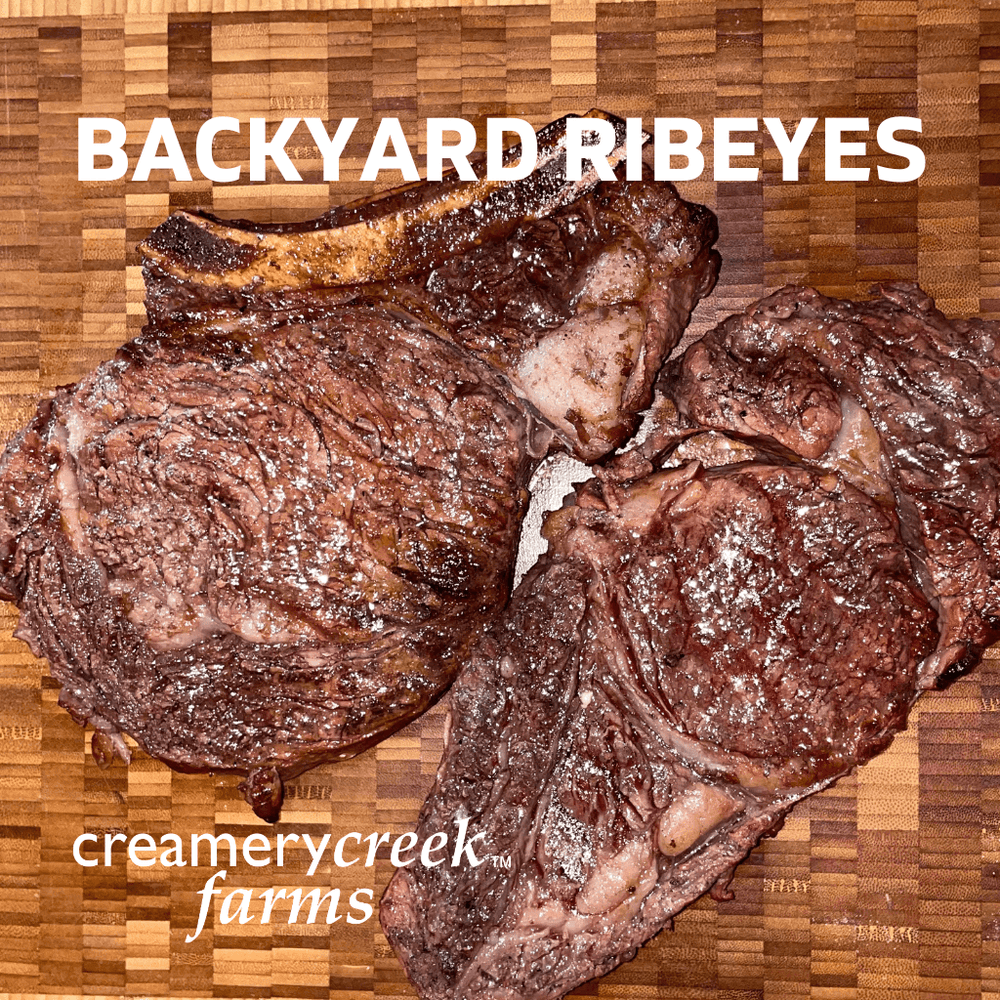
There’s a reason beef ribeye steak is a fan favorite. It’s rich. It’s tender. And when cooked right, it absolutely melts in your mouth.
At Creamery Creek Farms, we raise our dry-aged beef with care—from start to finish—so when it hits your grill, it’s already halfway to greatness.
But even the best cut deserves a little know-how. So whether you’re firing up the charcoal or using a cast iron pan, here’s how to make sure your ribeye steak is the star of your next cookout.
What is a Ribeye Steak, Anyway?
The ribeye comes from the rib primal, known for its high marbling and deep beefy flavor. It’s the same part of the cow that gives us prime rib, but the ribeye is cut into individual steaks.
Bone-in or boneless? That’s up to you. Bone-in ribeyes (sometimes called cowboy steaks or tomahawks) offer a bold presentation and slightly more flavor near the bone. Boneless ribeyes are a bit more manageable and equally delicious.
Why Dry-Aged Ribeye is Next-Level
Dry aging intensifies the flavor and tenderizes the meat. At Creamery Creek, we dry-age our beef for 21 to 28 days, depending on the cut. The result? A ribeye that’s rich, buttery, and beef-forward in the best way possible.
Think of it like the difference between a supermarket tomato and one fresh off the vine. Same idea. Huge difference.
Best Ways to Cook a Ribeye Steak
Let’s get into it. There’s no one-size-fits-all method, but here are my top tried-and-true techniques:
1. Grilled Ribeye Steak
-
Bring steak to room temp (30-40 minutes out of the fridge)
-
Season simply: kosher salt, cracked pepper. That’s it.
-
Preheat your grill—hotter the better
-
Sear 2-3 minutes per side over direct heat, then finish on indirect heat
-
Aim for medium-rare: 130–135°F internal temp
Let it rest. Seriously. Five minutes does wonders.
2. Cast Iron Ribeye (Rainy Day Win)
-
Heat your cast iron until screaming hot
-
Add high-smoke point oil (like avocado)
-
Sear both sides for 2-3 minutes
-
Optional: baste with butter, garlic, and rosemary
-
Finish in a preheated oven at 400°F if needed
Bonus tip: This method makes a glorious crust.
Ribeye Steak Tips for Backyard Chefs
-
Don’t over-season: Ribeye shines with simple salt and pepper
-
Use a thermometer: Guessing leads to overcooking
-
Rest before slicing: Keeps the juices where they belong
-
Cut against the grain: For tenderness in every bite
-
Buy quality beef: You can’t fake flavor
And if you're wondering where to start—yes, we ship dry-aged ribeyes nationwide.
Where to Buy Ribeye Steak Online
Not all steaks are created equal. Our Creamery Creek dry-aged ribeye steaks are raised on our family farm in Western Wisconsin, processed at a USDA-inspected facility, and shipped straight to your door.
No middlemen. Just real beef from real farmers who care. HI! That's us!
Perfect for date night, backyard BBQs, or stocking your freezer with something worth looking forward to.
Quick Recap: Ribeye Steak FAQs
What makes ribeye so good?
All that marbling! Ribeye is prized for its tenderness and flavor. Especially when dry-aged.
Should I choose bone-in or boneless?
Depends on your preference. Bone-in brings extra flavor and drama. Boneless is an easy classic.
How long to cook ribeye steak?
Depends on thickness and heat, but most average-sized ribeyes need 3-4 minutes per side for medium-rare. Use a thermometer to be sure.
Can I order ribeye steak online?
Absolutely. Just make sure it’s coming from a trusted source—like a farm that does things right (hi, that’s us).
When you’re cooking ribeye, you’re not just making dinner. You’re making a memory.
Start with the right beef. Treat it with respect. Keep it simple.
And invite someone to share it with you—because ribeye steak is even better with friends!
XOXO,
Louisa


